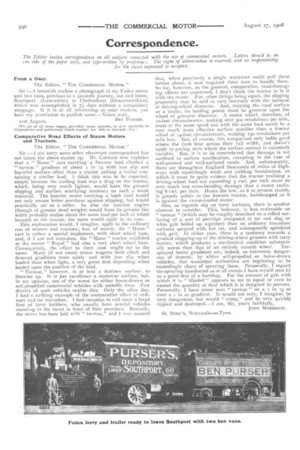Correspondence.
Page 18

If you've noticed an error in this article please click here to report it so we can fix it.
The Editor invites COrresPondence ott all subjects conne.led with the vse of commercial motors. Letters shent!ct be, on cne side of the paper only, and type.written by preferenc:. The right of abbreviation is reserved, and no responsibility for the views expressed is accepted.
From a User.
The Editor, " TETE COMMERCIAL MOTOR."
Sir herewith enclose a photograph of my Foden motor and two vans, previous to a 320-mile journey, out and home, Southport (Lancashire) to Cheltenham (Gloucestershire), which was accomplished in 7i. days without a compulsory stoppage. If it is at all interesting to your readers, you have my permission to publish same.—Yours truly,
21st August. BEN PURSER.
[We are at all times happy, provided space permits, to give publicity to illustrations and particulars winch readers arc able to forward.Et),I
Comparative Road Effects of Steam Motors and Tractors.
The Editor, "THE COMMERCIAL MOTOR."
Sir :—I am sorry some other observant correspondent has not taken the above matter up. Mr. Cornock now explains that a " Mann " cart carrying a five-ton load climbed a "tarmac " gradient of about I in 15 with less slip and harmful surface effect than a tractor pulling a trailer containing a similar load. I think this was to be expected, simply because the trailing load was a drag on the tractor, which, being very much lighter, would have the greater slipping and surface scarifying tendency on such a weak material. The heavier motor carrying a back load would not only secure better purchase against slipping, but would practically act as a roller. As also the traction engine (though of greater dead weight) would from its greater tire width probably realise about the same load per inch of wheel breadth as the tractor, the same would apply in its case.
This explanation would, I imagine, apply to the ordinary run of motors and tractors; but, of course, the " Mann " cart is rather a special implement, with short wheel base, and, if I am not mistaken, the " Mann " tractor exhibited at the recent " Royal " had also a very short wheel base. Consequently, the effect in their case might not be the same. Many (if not most) steam wagons both climb and descend gradients more safely and with less slip when loaded than when light, a very great deal depending when loaded upon the position of the load.
" Tarmac," however, is at best a dubious surface to theorise up. It is par excellence a motorcar surface, but, in my opinion, one of the worst for either horse-drawn or self-propelled commercial vehicles with metallic tires. Few drivers of such vehicles realise this. Only the other day, I had a striking example of the comparative effect of ordinary and tar macadam. I had Occasion to call upon a large firm of lorry builders, who usually have several vehicles standing in the street in front of their premises. Recently, the street has been laid with " tarmac," and I was assured that, when previously a single workman could pull these lorries about, it now required three men to handle them. So far, however, as the general, comparative, road-damaging effects are concerned, I don't think the tractor is in it with the motor. For, other things being equal, the slipping propensity may be said to vary inversely with the increase of driving-wheel diameter. And, treating the road surface as a brake, its holding power must be greatest upon the wheel of greatest diameter. A motor wheel, therefore, of to-foot circumference, making over 500 revolutions per mile, must at the same speed and with the same load surely be a very much more effective surface scarifier than a tractor wheel of I4-foot circumference, making 150 revolutions per mile less. But, of course, this comparison only holds good where the tires bear across their full width, and doesn't apply to paving setts where the surface contact is extremely variable. But, it is to be remembered that damage is not confined to surface scarification, excepting in the case of well-penned and well-surfaced roads. And, unfortunately, there are throughout England thousands of miles of highways with exceedingly weak and yielding foundations, on which it must be quite evident that the tractor realising a driving-wheel load not exceeding 5 cwt. per inch must do very much less cross-bending damage than a motor realising g cwt. per inch. Hence the law, as it at present stands, is grossly unfair to the five-ton tractor, handicapped as it is against the 12-Lon-loaded motor.
Also, as regards slip on tarry surfaces, there is another element to consider. This, however, is less noticeable on "
tarmac" (which may be roughly described as a rolled surfacing of a sort of porridge composed of tar and slag or whin grit boiled up together) than on ordinary macadam surfaces sprayed with hot tar, and subsequently sprinkled with grit. In either case, there is a tendency towards a gradual clogging-up of the driving-wheel grooves with tarry matter, which produces a mechanical condition substantially worse than that of an entirely smooth wheel. Tarsprayed heavy gradients are, indeed, so extremely dangerous of descent, by either self-propelled or horse-drawn vehicles, that municipal authorities are beginning to be exceedingly chary of spraying these. Personally, I regard tar-spraying (conducted as at all events I have myself seen it) as a good deal of a humbug. For the amount of grit with which it is " blinded " appears to me to equal or even to exceed the quantity of dust which it is designed to prevent. Personally, I have never seen " tarmac" on a I in 15 oreven a s in 20 gradient. It would not only, I imagine, be very dangerous, but would " creep," and be very quickly rippled and destroyed.—1 am, Sir, yours faithfully, JOHN MORRISON.




















